Cross-Cultural Connections, Confluences and Contradictions in Masked Performance
The Body and Mask in Ancient Theatre Space Project
by Margaret Coldiron
University of Durham
In September 2006 I joined the Arts and Humanities Research Council-funded project on The Body and the Mask in Ancient Theatre Space run jointly by the Department of Classics and Ancient History at Durham University and King's Visualisation Lab (KVL), part of the Centre for Computing in the Humanities based at King's College London. It is a multi-faceted project that includes not only analysis and virtual reconstruction of ancient artefacts and architecture, but also practical intercultural performance research, which hopes to shed light on ancient performance practice. As a specialist in Asian performance and masks, my role in the project involves working with performers from Asian mask traditions using both their own masks and Greco-Roman masks specially made for the project from three-dimensional models of ancient terracotta miniatures dating from c.50 BC to c. AD 200 (corresponding to periods 4, 5 and 6 in Webster and Green 1995).
This system for creating usable, full-size masks from artefacts has already been tested in an earlier, related AHRC project by Prof. Elizabeth Moignard and Dr. Richard Williams (University of Glasgow), that investigated the New Comedy masks of Menander. Dr. Williams, now at Durham University, is a senior researcher on the current project, which is jointly directed by Professor Richard Beacham and Dr Hugh Denard of King's Visualisation Lab in the Centre for Computing in the Humanities at King's College, London.
The ancient mask artefacts are captured through photogrammetry or laser scanning, then digitally rendered and scaled up using three-dimensional modelling techniques. Selected examples of these virtual models are then made into full-sized, three-dimensional masks through rapid prototyping. The prototypes are cast in plaster to create negative moulds from which functional masks can be made. In practical research sessions, we work with master performers whose movements are recorded using both the Gypsy electro-mechanical exoskeleton for three-dimensional motion capture and ChromaKey ("blue screen") video in high definition to record performers in actual mask and costume. This digital material is then incorporated into virtually-reconstructed, ancient theatre spaces.
The Gypsy exoskeleton records the performer's movement and is realised visually on simplified stick-figure that moves in the three-dimensional virtual environment. Eventually an avatar is designed, presenting a human figure that can be costumed and observed from all angles. However, the process of creating and clothing the avatar is highly complex and time consuming, whereas the ChromaKey technology produces more immediate results, but remains essentially two-dimensional. Using both technologies provides us with a wide range of research options.
The first phase of this work has involved collaboration with the distinguished Nô performer, Akira Matsui, in intensive sessions of practical research held in February and May of 2007. Compared with what might be regarded as typical research in the field of Classics, this dynamic investigation of the interaction of space, mask, performer and performance is unusual in that it seeks to shed new light on the relationship between body, mask and space by exploring ancient practice as if present, by means of the virtual world.
Why Cross Cultures?
The work gives rise to a number of questions: Why connect with Asian mask traditions in studying Greek masked performance? What can these two cultures—ancient Greek and Japanese—possibly have in common? How can one justify putting a Nô performer into a Greco-Roman mask in a Greek play on a Greco-Roman stage?
In recent years a number of Classics scholars have published interesting comparative work noting shared elements in the mask traditions of Asia and ancient Greece and Rome (for example, Smethurst 1989, Wiles 1991 and Csapo and Miller 2007). Moreover, from the European point of view, Greek culture is famously situated at the confluence of East and West. However, it would be wrong to imagine that the notion of masked performance migrated east from ancient Greece or that Greek theatre derives from Asian models; presumed or imagined historical contacts are not the rationale for these experiments. What these Asian cultures can offer to researchers of ancient Greek and Roman masks is contact with an unbroken tradition of masked performance with a visceral understanding on the part of performers about how masks work and how to make masks work expressively.
Although there is a tendency to trace Western theatrical roots to ancient Greek performance, we know remarkably little about it. Literature on theatre history relies mostly on fragments of text, vase paintings and the surmises of generations of classical scholars whose guesses may or may not have any validity. To borrow a phrase from that great artist and thinker, Donald Rumsfeld, the reality of Greco-Roman masked performance lies in the realm of "known unknowns". More recently, however, research into ancient performance and the functioning of masks has moved away from looking only at textual and visual evidence and has now begun to focus on the experience of the performer. This approach assumes that there are some fundamentals in human behaviour and perception that are shared by all humankind, across cultures and through history. Such an assumption has its risks, of course, and one must take account of the nuances of culture, including custom, religion, ethics and even fashion. Ekman's study of the interpretation of facial expression has demonstrated, in the realm of the physical manifestation of emotion, that human animals tend to behave in similar ways regardless of culture and are able to communicate with one another through physical means.
Why collaborate with a Japanese Nô actor, rather than a skilled and experienced Western performer, familiar with the literature and, to some degree, with the iconography? The answer is simply that European and North American performers are hindered by nearly two thousand years in which theatrical masking has suffered from official disapproval from the Church, particularly in the early Christian period, because of the association of masks with pagan rites and celebrations.
Although there are numerous examples of masks and masking, including masked theatrical performance, in Christian Europe—the most obvious example being the Italian commedia dell'arte—the antipathy of the Roman Catholic church and wider Christian culture to masks is well documented (Coldiron 2004 pp.3-6 and De Marinis 1995). Most importantly, in spite of these examples, it is clear that there has been no continuous tradition of masked performance dating from Ancient Greco-Roman theatre to the present day.
Added to this is the negative and pervasive influence of a school of acting which may be termed realistic and psychological that implicitly and explicitly rejects the stylisation that masked performance almost inevitably requires. On the other hand we can learn a great deal from a performer trained since childhood in a highly stylised form of masked performance which, like ancient Greco-Roman theatre, involves music, dance, singing and chant.
What follows is a brief outline of the way in which these two performance cultures were brought together for this work.
Translating Performance Across Cultures
The Masks
Comparisons between two very different theatrical cultures become easier when one looks for points of contact, and I began by looking for similarities between our terracotta artefacts and the masks of Nô. The best starting point seemed to be to find masks of similar type. (It is important to note here that we are looking at mask artefacts, rather than character types that appear in the dramatic texts.) The classification of masks, especially in long-established theatre forms, is a complex issue. Masks are generally created in the first instance to meet the needs of particular performers or performances and not to coincide with a system of classification, should any exist. In looking for a system, those who study Greek and Roman masks generally turn to Pollux and his Onomasticon (IV, 143-154), which appears to provide a fairly comprehensive list of dozens of mask types for both comedy and tragedy. However, as Webster and Green (1995) attest, Pollux's list does not entirely coincide with the surviving evidence. Webster (1995, Vol.1, p.6) observes that Pollux:
is a problematic source. The author was interested in glosses, not in realities [...] What has come down to us is an epitome, not the original work, and copying in the Middle Ages—when the subject-matter was even more obscure—inevitably brought corruption to the text.
His further detailed discussion is very revealing. To complicate matters further, the highly-sophisticated, Japanese classical theatre tradition is equally convoluted: there are approximately 150 existing types of Nô mask (Nakamura 1984, Pulvers 1978), each of which has its own, carefully-documented, unique design qualities. Nevertheless, masks of both ancient Greco-Roman theatre and Nô can be divided into groups roughly based on age and gender. Taking into account that there may be a complex of subdivisions within these groups, Pollux provides us with the following major types:
- Old man
- Young Man
- Female
- Slave
- Old Man
- Young Man
- Female
- Demons/Gods/Spirits
Our methodology involved finding representative masks from each type that might be similar enough to use comparatively. We began with a 4th century terracotta model from Lipari of a mask referred to as Philoctetes—the central character of Sophocles' play of the same name—which resides in the Kelvingrove Museum, Glasgow (discussed in Brea and Cavalier 2001, pp. 33-35, figures 5a and b; Plate 1). There is no evidence that the mask might represent that particular character, but it does possess the characteristics that might be typical of a young warrior.
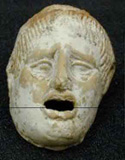 |
| Plate 1 The "Philoctetes" miniature from Lipari. |
The expression of concern indicated in the up-drawn brows is particularly striking and reminiscent of the Nô mask called Chujo, which is also used for young warriors (Plate 2).
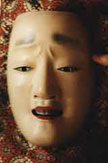 |
| Plate 2 Chujo mask by Michishige Udaka. |
In order better to understand a Nô performer's approach to this character type, we first asked Matsui to demonstrate a section of the play, Kiyotsune, in which the Chujo mask is typically used, about a sensitive young samurai of the Tiara clan who commits suicide after a battlefield defeat. We captured this work on video and in three-dimensional motion capture using the Gypsy 5 exoskeleton both with and without the mask.
The Characters
We then set out to try to find an equivalent character in the classical Greek canon that would correspond, and found what seemed to us to be a very good match in Ajax, the central character of Sophocles' tragedy of the same name. The story runs as follows: Ajax has been promised the arms of his comrade Achilles, who was killed in battle, but they are awarded instead to Odysseus. As a result, Ajax goes mad with grief and frustration and slaughters a herd of cattle under the delusion that they are the generals by whom he feels betrayed. When he emerges from this fugue and realises what he has done, Ajax is deeply humiliated and commits suicide.
We provided Matsui with a literal Japanese translation of the long soliloquy that Ajax gives immediately before his suicide (lines 815-867) and asked him to develop his own interpretation of the character using the speech and inspired by the model of the Greco-Roman mask which we had scaled up to full-size.
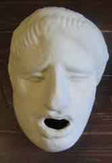 |
| Plate 3 Full-sized rapid prototype shell of Philoctetes mask. |
In our experiments in February 2007, this work began to develop very interestingly and Matsui tried two interpretations of the speech and character. The first involved a direct acting-out of the narrative as it develops in linear fashion; Ajax places his sword, prays to the gods, considers the grief of his family and friends, bids farewell to the earth and falls on his sword. The second interpretation followed a non-linear pattern more typical of the construction of a Nô play in which, after planting his sword into the sand, Ajax relives the circumstances that have brought him to this moment as if in a flashback, and then returns to the present with a strong resolve and commits suicide. The research team were pleased with the work, which Matsui continued to develop in the period between the two practical research sessions. By the time he returned in May 2007, Matsui had created a full 12-minute piece based on the Ajax soliloquy with full Nô costume and mask.
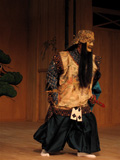 |
| Plate 4 Matsui's Nô version of Ajax with Kantan mask and Chinese costume. |
Because the play and character are Greek and not Japanese, he chose a costume and mask typically used for Chinese or foreign characters. The mask he selected was not Chujo, which he felt was too sensitive for the character of Ajax. He pointed out that, although both Ajax and Kiyotsune are warrior characters who commit suicide, Ajax truly is a warrior whose suicide is directly related to a perceived insult to his warrior status but Kiyotsune is a warrior by default who dies because he is unhappily unsuited to the role. Thus, the mask that Matsui chose for Ajax is one called Kantan, and is generally only used for the play of that name. Kantan is the story of a Chinese man who leaves his home to seek knowledge. He stops one night at an inn, where he lies down to rest. A royal envoy comes to appoint him emperor and he lives a life of luxury for fifty years. Then, he is suddenly awakened by the voice of the innkeeper and realises that "life itself is a momentary dream" and he returns to live quietly at home. (O'Neill 1953 p.71) Matsui felt that this mask was more appropriate because it looked less racially Japanese and had some of the manic quality of madness that Ajax demonstrates in his slaughter of the animals.
Matsui was also asked to perform as Ajax in a mask and costume based on Greco-Roman models and to adjust his performance by imagining himself to be in a medium-sized Roman theatre. The mask was a full-size version of the Lipari terracotta. The prototype "shells" derived from the three-dimensional models were created at Durham University. These were then cast in plaster and the masks were built using silastic and painted by Dr Malcolm Knight of the Scottish Mask and Puppet Centre, Glasgow, who had previously participated in the AHRC New Comedy Mask Project. The costume—researched, developed and created by Sao Murato of Thiasos theatre company in consultation with, among others, Rosie Wyles in the Department of Classics at Royal Holloway, University of London—was based on that worn by an actor depicted on a 4th-century, red-figure vase from Tarentum.
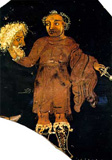 |
| Plate 5 Actor in costume with mask, Tarentine Vase, Würzburg, No.832. |
Perhaps not unsurprisingly, Matsui's physicalisation of the role in these circumstances was more expansive and, while still stylised, seemed more realistic than the Nô-based interpretation.
All of this work has been captured on high-definition digital video using ChromaKey technology so that the performance can be placed into the virtually realised ancient theatre spaces. The initial research results have already proved very interesting and further development of this material is in process and will be made available in due course.
We worked in a similar way developing the Tragic Female character. Our research began with gathering motion-capture data of Nô female characters within the range of the Zo-onna mask, including Lady Rokujo in Aoi no Ue and the itinerant dancer in Dôjôji. Each Nô school has its own particular traditions with regard to the choice of mask for any given play and the Zo-onna is only one of several possibilities for these characters when they appear in human form. The Kongo school, for example, traditionally uses the brass-eyed, semi-divine Deigan mask for the Lady Rokujo's first appearance. Both of these characters are women of middle years who transform into demonic figures and must be exorcised in the course of the play.
As Greek cognates, Matsui chose Medea and Agave from Euripides' Bacchai, both of which are characters he has worked on in his own creative endeavours. It was Agave that seemed to be best suited to our Tragic Female mask. This mask was derived from a model housed in the Kelvingrove Museum in Glasgow (1903.70dt.9; Webster and Green, 1995, Vol. 3 (1ST46c); Brea 1981, p.230; Brea and Cavalier, 2001 p.230, fig. 364), previously identified as the "Golden Heteira" of New Comedy, but strong evidence has recently emerged that may justify its reclassification as a tragic mask.
We were able to produce a short video of Agave's return from Kithairon with the head of her son, Pentheus (Clip 1). This performance was placed, virtually, on the stage of the Odeion of Agrippa, a Greco-Roman theatre which now lies in ruins in the ancient Agora of Athens, but which has been digitally reconstructed by Martin Blazeby at King's Visualisation Lab. The performance was set to"Eastern Mirror" by Palle Dahlstedt, a piece commissioned for Noho's twentith anniversary in 2001, which mixes Nô instrumentation according to johakyu progressions. Matsui created a striking performance that begins to give one an idea of how the body of the actor and the ancient mask might interact in that space.
Clip 1 Matsui Akira as Agave in Euripides' Bacchai in a virtual reconstruction of the Odeion of Agrippa, Athens, by Martin Blazeby.
ChromaKey and video production, Michael Takeo Magruder. © King's College London 2008.
The free QuickTime Plugin necessary to view these clips can be downloaded from http://www.apple.com/downloads. In order to see the full extent of the stage area, the camera viewpoint is placed in the fifteenth row of the auditorium, with the result that the subtleties of Matsui's work with the mask are not entirely clear. However, while we were filming this performance using the ChromaKey technology and high definition camera, I also made a short study video using my digital still camera. In spite of the low resolution, this file (Clip 2) provides an opportunity to see Matsui's performance in close-up.
Clip 2 Akira Matsui in rehearsal as Agave in Euripides' Bacchai.
Body and Mask in Performance
For those unfamiliar with Nô performance, a few observations need to be made at the outset. Nô theatre is a highly stylised court art that, like much else in Japanese culture, became rigidly codified during the Tokugawa period (c.1600-c.1850). The basic stance (kamae) of the Nô performer is a posture in which the actor stands with feet in parallel about 3-4 inches apart, weight forward and knees bent. Arms are at the side, rounded and held slightly away from the body with each hand in a light fist with the thumb forward. The Nô walk (suriashi) is often described as a shuffling step in which the feet glide along, only leaving the floor for occasional rhythmic stamps that occur at theatrically-important moments of the drama. This physical discipline has the effect of keeping the body and mask still while moving, as if floating over the stage. The subtle movements of the Nô mask, which are delineated in the traditional choreography recorded in the katazuke manuals of each Nô school, are quite striking, coming as they do from this physical atmosphere of stillness, and give a powerful illusion of life. Used by a skilled actor, the Nô mask will seem to breathe.
In his performance of Agave using the Greco-Roman mask and costume, Matsui has adapted his physical performance a great deal. It will be noted that, although he still uses a shuffling step, his knees are straight and his movement overall is (by Nô standards) thoroughly naturalistic. Nonetheless, when Agave casts her first look directly at the head (mask) of Pentheus, Matsui uses the sharp kiru (cutting) movement of the mask, a technique that is most often used by demonic or mad-woman characters in Nô. S/he holds the head away and moves backward as if to retreat from what s/he sees, then moves forward but with a slightly downward gaze, giving the impression of introspection as s/he kneels to contemplate the implication of what s/he has seen and (perhaps) done. When s/he looks again at the head of Pentheus, the movement is entirely naturalistic, but a slight, sharp inclination of the head—a softer kiru—lends intensity to this second gaze. Suddenly, and in time with the music, Matsui takes two sharp steps to move from kneeling to a standing position, looking with real horror and a dawning realisation of what is before him/her, and then reels backwards, recoiling from the sight. S/he comes forward and looks again, then with another sharp kiru movement turns away from the face s/he sees, as if seeking reassurance from Kadmos. After recoiling a second time, Matsui manages to make the mask appear unfocused and distracted as the terrible realisation dawns upon Agave of what she has done. In a gesture reminiscent of those used to manipulate kimono sleeves in Nô, Matsui sweeps Agave's shawl around the pole on which Pentheus's head is impaled, as if cradling a child. Eyes averted, s/he sinks to her knees and gently places her dreadful trophy on the ground, suddenly collapsing as s/he sees the face again and draws her arm in front of her as if to push the sight away. The scene ends with a tableau of the grief-stricken mother hardly able to face what she must now acknowledge.
This is a very carefully modulated performance with nothing left to chance. Each nuance has been meticulously choreographed with minute attention to every musical and physical gesture. By these means, the mask comes alive in such a way that its fixed countenance seems to move through a range of different emotions, even in this brief excerpt. This is achieved through a skilled use of stillness, punctuated by sharp "cuts" and contrasting sustained movement of the mask, which is given further definition by precise angling of the body and a highly selective vocabulary of gesture that suggests much by doing very little.
 |
| Plate 6 Akira Matsui as Agave. |
This is very far from being a performance that would have been seen in ancient Greece or Rome, but it does show us how this object, which seems rather dull as a terracotta artefact, can become a fully-expressive, theatrical tool when used by a master performer who has at his command a carefully-honed technique for working expressively with masks.
Working with Matsui
The opportunity to work with Matsui Akira has been one of the great benefits of taking part in this research. He is an exceptional performer of international stature, and designated an "Intangible Cultural Asset" in Japan. He has collaborated with theatre artists around the world, most recently with Eugenio Barba and his Ur-Hamlet. The astonishing fecundity of his creative imagination and the absolute perfection of his skill have awed and inspired all of those who have had the privilege of collaborating with him in these sessions. We are only beginning to be able to assess, interpret and develop all that we have been learning from his work with us.
I have been particularly impressed by his ability to make sense of these alien masks, which have been created according to very different criteria than any usual theatrical masks. They are made without reference to either aesthetic beauty or theatrical expressivity, but rather as an attempt to test the viability of these artefacts, the mask miniatures, which are amongst few three-dimensional examples that remain from a great tradition of Greco-Roman masked performance. Vase and wall paintings of masks are of course useful to a degree, but are generally (and frustratingly) idealised, so that they do not appear to be masks when worn by the painted figure. Moreover, being two-dimensional they do not provide the kind of evidence regarding details of facial features, helmet shape and construction that can be gleaned from the three-dimensional mask models. As theatrical objects, the masks are flawed in a number of ways and yet this gifted actor has been able to bring them to life. The quality of the work he has produced, particularly in terms of finding the expressive capacity of these masks, I believe vindicates the controversial choice of using Asian master mask performers for this work.
Future Developments
The work of the project will continue through early 2009 and will include collaborations with other theatre artists including Italian commedia dell'arte actors and the distinguished Balinese performer and scholar, Dr I Wayan Dibia. The potential applications for the results of this project are exceptionally wide-ranging, having implications for the disciplines of Performance Studies, Classics, Theatre History and Psychology as well as other realms of digital arts and Media. The team will hold further conferences as the research develops.
Dr Margaret Coldiron is Research Fellow with the AHRC "Body and Mask in Ancient Theatre Space" Project.
Acknowledgements
Thanks to Martin Blazeby and Michael Takeo Magruder of King's Visualisation Lab, for preparing images and video clips for this publication, and to Jonah Salz for information on Palle Dahlstedt's "Eastern Mirror". Thanks, in particular, to Matsui Akira for his inspiring conversations and performances during the "Body and Mask in Ancient Theatre Space" Project.
References
BREA, L.B., 1981. Menandro e il teatro Greco nelle terracotta liparesi. Genova: Sagep.
BREA, L.B. and CAVALIER, M., 2001. Maschere e personaggi nel teatro greco nelle terracotte liparesi. Roma: 'L'Erma' di Bretschneider.
COLDIRON, M., 2004. Trance and Transformation of the Actor in Japanese Noh and Balinese Masked Dance-Drama. Lewiston, Queenston, Lampeter: Edwin Mellen Press.
CSAPO, E. and MILLER M.C. (eds), 2007. The Origins of Theater in Ancient Greece and Beyond — from Ritual to Drama. Cambridge: Cambridge University Press.
MARINIS, M. de, 1995. The Mask and Corporeal Expression in 20th-Century Theatre. Translated by B.K. Emerick. In: T. Leabhart, ed. Incorporated Knowledge (Mime Journal). Claremont, CA: Pomona College, 14-37.
NAKAMURA, Y., 1984. Nô Masks. In: Nô/Kyogen Masks and Performance, R. TEELE, ed. Mime Journal No. 10, Claremont CA: Pomona College, 114-124.
NAKANISHI, T. and KIYONARI, K., 1983. Noh Masks. Translated by D. Kenny. Osaka: Hoikusha Publishing Company.
O'NEILL, P.G., 1953. A Guide to Nô. Tokyo: Hinoki Shoten.
PULVERS, S.H., 1978. The Nô Mask and the Maskmaking Tradition. Thesis (PhD). Australian National University.
SMETHURST, M.J., 1989. The Artistry of Aeschylus and Zeami: A Comparative study of Greek Tragedy and Nô. Princeton NJ: Princeton University Press.
WEBSTER, T.B.L., 1995. Monuments Illustrating New Comedy. 3rd ed. revised and enlarged by J.R. Green and A. Seeberg. 3 vols. London: Institute of Classical Studies.
WILES, D., 1991. The Masks of Menander: Sign and Meaning in Greek and Roman Performance. Cambridge: Cambridge University Press.
